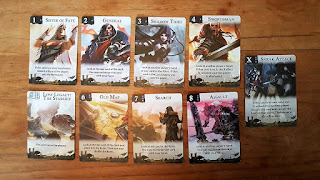Lost
Legacy: The Starship
Players: 2-4 players
Publisher: Alderac Entertainment Group
Year: 2014
Publisher: Alderac Entertainment Group
Year: 2014
Microgames
are games that are supposed to be, as their name indicates, small and quick. A
famous example is Loveletter, which is ranked highly on BGG. So let’s see how
this game plays out.
 |
| The cards |
Gameplay
can be summarized as locating the starship or eliminating all other players
before the starship is discovered. While it sounds easy, there is a surprising
amount of strategy to this game. The cards are shuffled, everyone is given a
card and one card is placed aside to form the ruins. The game is divided into
two phases, the playing phase, where people can be eliminated and the
investigation phase. In the playing phase cards the active player draws a card
and plays one of his two cards. Other players can be eliminated here by placing
ambushes other players. Also the starship’s location can be moved with certain
cards. If no more cards can be drawn, the investigation phase starts and
players can guess where the starship is based upon the order as indicated by the number in the corner of the card that they are holding until either the starship is found or everyone guessed wrong,
in which case everyone loses.
 |
| The famous starship everyone is looking for. |
There is
not much that I don’t like about this game. To put it rather simple, it doesn’t
pretend to be anything more than that it is. The game light and quick. Sure, a
more challenging game would be nice, but that would deviate from what it sets
out to be. Perhaps a minor detraction would be the felt bag that comes with the
game. While it’s not bad, it’s an interesting way of storing the game and I
must admit that I have lost track of where I kept this game a few times. While
there is a certain lore in this game, it could be utilized more. However,
again, this could detract from the microgame-principle. Also, the game doesn’t
play as well with two players as with three or four people, but that might be because the game is so small.
 |
| The extra components |
I’d like to
point out that this game is the first in a series. These can be mixed and
shuffled to create special decks. However, since I haven’t played any of the
other games, so I can’t say a lot about it.
So the
verdict? The game is enjoyable and an addition to every collection, both due to
size and budgetary constraints. While not every group may enjoy this game, it’s
a light filler that can easily be whipped out and put away again. However, if
you are looking for heavier games, you might want to continue searching.









